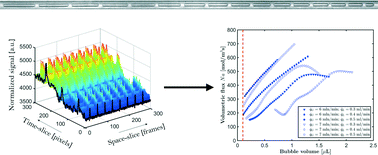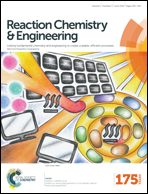A model-based technique for the determination of interfacial fluxes in gas–liquid flows in capillaries†
Abstract
We present a novel technique to quantify interfacial mass transfer in gas–liquid flows in capillaries. A model was developed which allowed the relationship between absorption fluxes and bubble size changes to be established. Depending on the observed absorption rate, two limiting and simplifying cases for low and high absorption rates were suggested. For both cases, the flux was viewed as an input function which optimally tracked the observed bubble velocity, bubble volume, and unit cell volume change. For the case of low absorption rates, the mass transfer coefficient can be assumed to be constant and the model was fitted to experimental data by adjusting the value of this mass transfer coefficient. The bubble velocities were extracted from flow images using the cross-correlation between measured signal intensities for nearby pixels. Bubble and unit cell volumes were not determined by individual tracking, but a probability density function was estimated for each location in the capillary which contains the bubble and unit cell sizes of all bubbles passed. This allows the model to be fitted to an ensemble of bubbles making the procedure more robust. The developed model was validated for CO2 absorption in a buffer solution, and then applied to CO2 absorption using the ionic liquid 1-ethyl-3-methylimidazolium acetate ([Emim][Ac]), which exhibits high absorption rates and less known thermophysical properties. The developed technique is able to quantify interfacial fluxes for a wide range of gas and liquid flow rates.


 Please wait while we load your content...
Please wait while we load your content...